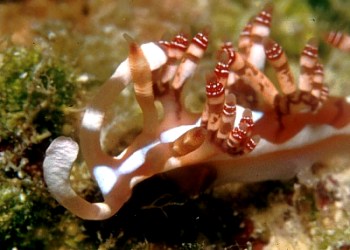
Flabellina bilas
(Gosliner & Willan, 1991)
Order: NUDIBRANCHIA
Suborder: AEOLIDINA
Family: Flabellinidae
DISTRIBUTION
Probably widespread in Indo-West Pacific
PHOTO
Kwajalein Atoll, Marshall Islands. PHOTO: Scott Johnson. See further photos below
Reference:
• Gosliner,T.M. & Willan,R.C. (1991) Review of the Flabellinidae (Nudibranchia: Aeolidacea) from the tropical Indo-Pacific, with the descriptions of five new species. The Veliger, 34(2): 97-133.
Rudman, W.B., 1999 (July 1) Flabellina bilas (Gosliner & Willan, 1991). [In] Sea Slug Forum. Australian Museum, Sydney. Available from http://www.seaslugforum.net/find/flabbila
Related messages
Flabellina bilas from Raja Ampat
June 15, 2007
From: Wendy Atkinson
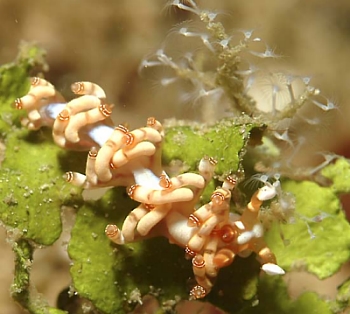
Which Flabellina could this be? Sorry about the terrible head shot...
Locality: Raja Ampat Islands, West Papua, Indonesia. Photographer: Wendy Atkinson.
Wendy Atkinson
wendyatkinson@comcast.net
Atkinson, M.W., 2007 (Jun 15) Flabellina bilas from Raja Ampat. [Message in] Sea Slug Forum. Australian Museum, Sydney. Available from http://www.seaslugforum.net/find/19318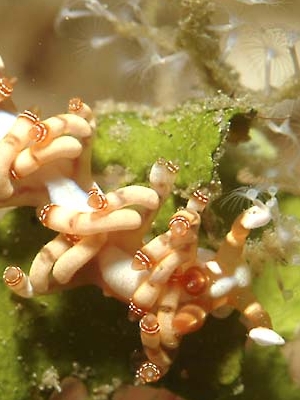
Dear Wendy,
This is Flabellina bilas. Although I can't see the head, the banding on the cerata is quite characteristic for this species.
Best wishes,
Bill Rudman
Flabellina bilas from the Red Sea
June 24, 2003
From: Harro H. Quitzau
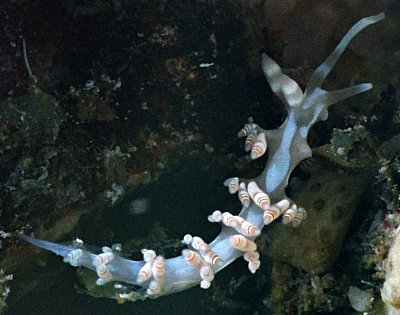
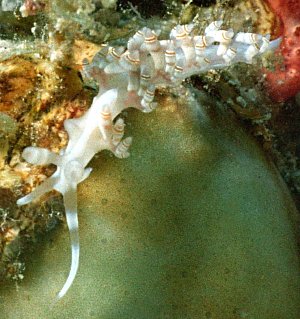
Hello Bill,
I found this Flabellina bilas at my last trip to the Red Sea.
Egypt, Safaga - Shaab Hamdalla
31 May 2003 - 22,5m - Size 3cm
Best wishes,
Harro
Harro@Quitzau.info
Quitzau, H, 2003 (Jun 24) Flabellina bilas from the Red Sea. [Message in] Sea Slug Forum. Australian Museum, Sydney. Available from http://www.seaslugforum.net/find/10243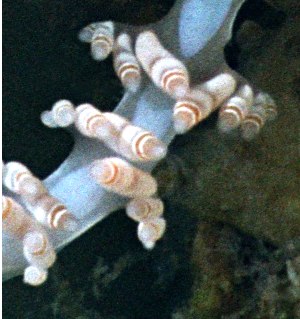
Thanks Harro,
After Lindsay Warren's record of an animal from Madagascar, I predicted this species was probably widespread throughout the Indo-West Pacific so your record from the Red Sea pretty much allows us to say it is widespread throughout the Indian Ocean and so confirms its wide distribution.
Best wishes
Bill Rudman
Flabellina bilas from Madagascar
February 22, 2002
From: Lindsey Warren
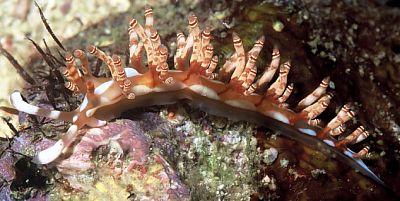
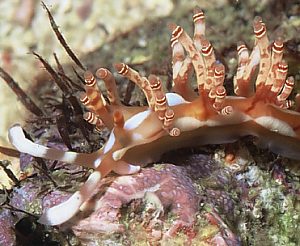
Dear Bill
Another specimen found during my recent trip to Madagascar. I found this Flabellina bilas on 22 January 2002 at about 1pm while diving on La Baleine rocks in the Iles Mitsio, NW Madagascar. It was crawling on rubble at a depth of 63 ft. L: 40 mm. Photo: Lindsay Warren.
Am I right in thinking that the red 'vein' leading into the cerata is part of the digestive system? If so, what is the orange mass which runs most of the length of the body? If part of the digestive system, why the difference in colour? Incidentally I have close-ups of the head and cerata should you want them for the Forum.
Looking forward to your comments.
All the best
Lindsay
alldcl@compuserve.com
Warren, L., 2002 (Feb 22) Flabellina bilas from Madagascar. [Message in] Sea Slug Forum. Australian Museum, Sydney. Available from http://www.seaslugforum.net/find/6224Dear Lindsay,
Thanks for this photo. Yes the reddish dict is the digestive gland duct which runs up the centre of each cerata. The orange mass, which is not clear in the photo, will be the lobes of the ovotestis. In most aeolids the digestive gland is restricted to the cerata. Exceptions are Protoaeolidia atra which has a large section of the digestive gland within the body cavity, and those aeolids with symbiotic zooxanthellae. In these animals there is a fine network of ducts throughout the body wall to accomodate the symbiotic plants.
Concerning other photos. I would be happy to look at them - if they show interesting details of the head, rhinophores and cerata, they would be very welcome. This find is quite a major range extension for the species. It was described from Marshall Ids and Papua New Guinea and I don't know of other records further afield. Your record is certainly the first from the western Indian Ocean which would suggest that the species is probably widespread throughout the Indo-West Pacific.
Best wishes,
Bill Rudman
Photos of Flabellina bilas
June 28, 2000
From: Scott Johnson

Hi Bill,
Looking over some of last year's messages, I noticed your request for photos of Flabellina bilas. Here are shots of two different individuals from Kwajalein in the Marshall Islands. Both were in the 45-55mm range.
Scott
johnson@kmr.ll.mit.edu
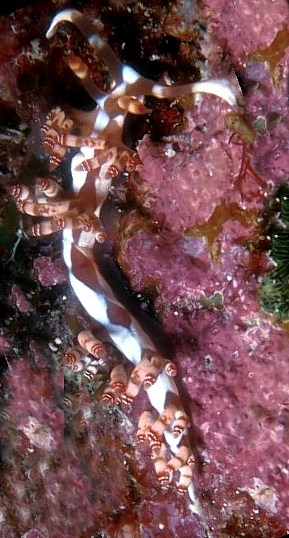
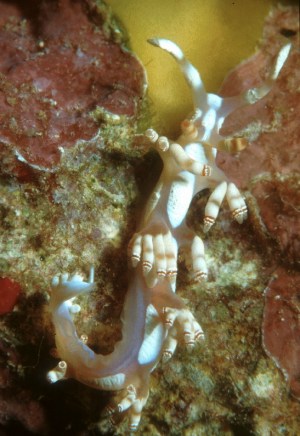
Dear Scott,
Thanks for your photos. I am particularly pleased with the UPPER photo which clearly shows the paddle-shaped oral tentacles. I have seen these in specimens of Flabellina bicolor and in a photo of F. bilas in Gosliner & Willan's paper. However no one seems to have commented on it. To see them sofly 'banging' their paddles down on the substrate as they crawl along is a quite remarkable sight. I don't understand its function and I have seen animals with apparently normal oral tentacles, so I can't even guess what's going on.
If you, or anyone else, has noticed this behaviour in any Flabellina I would be interested in hearng about it.
Best wishes,
Bill Rudman.
Flabellina bilas
June 29, 1999
From: Grey McNeil
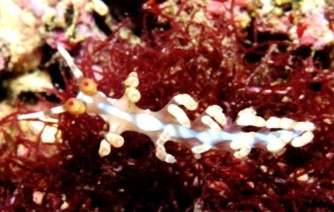
Dear Bill,
Could you identify this photo please. The details are:
RASCHS REEF, MADANG, Papua New Guinea, 2cm long, 5m Jan 1999.
Thanks,
Grey McNeil.
GREYMACIND@bigpond.com
McNeil, G., 1999 (Jun 29) Flabellina bilas. [Message in] Sea Slug Forum. Australian Museum, Sydney. Available from http://www.seaslugforum.net/find/992I think this is Flabellina bilas which is similar in shape to Flabellina bicolor but has a red ring on the upper half of each ceras with a white band above and below it. Unfortunately I don't have a good photo of this species to put on the Forum but hopefully someone will help us out.
Bill Rudman.
Rudman, W.B., 1999 (Jun 29). Comment on Flabellina bilas by Grey McNeil. [Message in] Sea Slug Forum. Australian Museum, Sydney. Available from http://www.seaslugforum.net/find/992